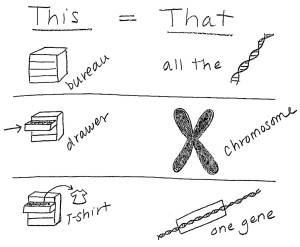Chromosomes
Chromosome! Does that word scare you? Let’s tone it down a bit. From now on, instead of saying chromosome, I shall say chromie-somie. It’s more fun to say, it is more fun to type, and it involves a hyphen. These are all excellent qualities.

A chromie-somie look like a mildly overweight X.

Chromie-somies are the way DNA is packaged in the cell when it’s not being used. It’s like a clothes dresser. When you are not using your clothes, you fold them and place them ever so gingerly in a drawer (theoretically, that is). By folding and storing them so, you are keeping them safe from damage and unnecessary wear.

You open the drawer and select a specific article only when you need it. You wear it, and then when you’re done, it goes back in the drawer (after washing it, if you are really on top of things). If you just leave your clothes anywhere and everywhere, your clothes will get wrinkled, dirty, and frayed.



In this analogy, the bureau is the genome, the drawer is a chromosome–I mean, chromie-somie, and the articles of clothing are individual genes. The act of selecting a shirt from the drawer is the way a cell unwinds the DNA to get to a specific gene, and then puts the DNA away again.

Now for structure: chromie-somies are DNA that is wrapped around proteins called histones, which are then stacked on top of each other like balls of yarn. Again, it’s all about protecting the DNA from damage. You want to store is neatly and compactly.

We human beings (for I assume no walruses read this blog), have 23 pairs of chromosomes, for a grand whopping total of 46. You have pairs of chromosomes because you get a set of 23 chromosomes from each parent.

For every single gene in the human genome, you have 2 copies. It’s a great system because if you get a “broken” gene from 1 parent, you still have a chance of getting a “working” gene from the other parent. Nature hedges her bets. She’s so smart.



